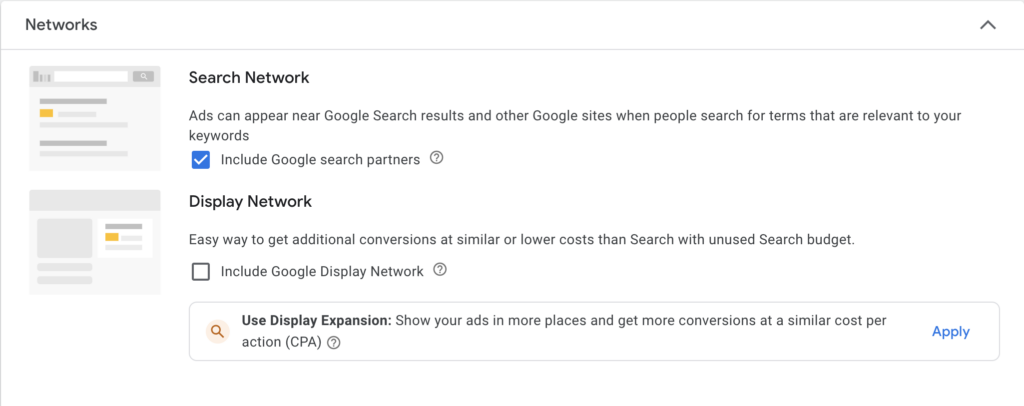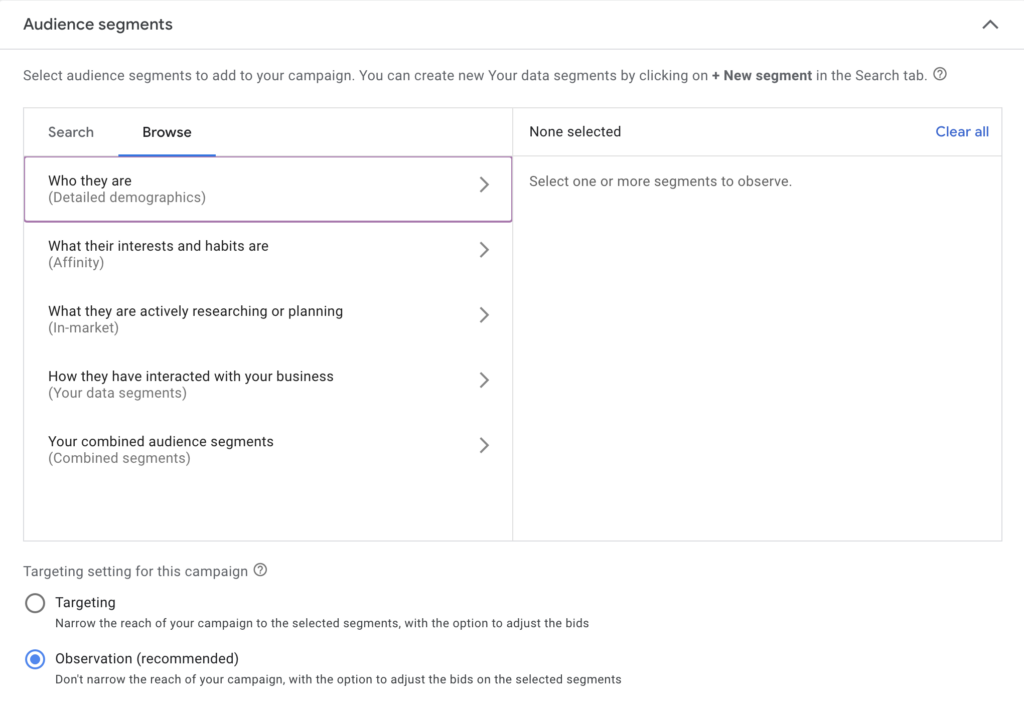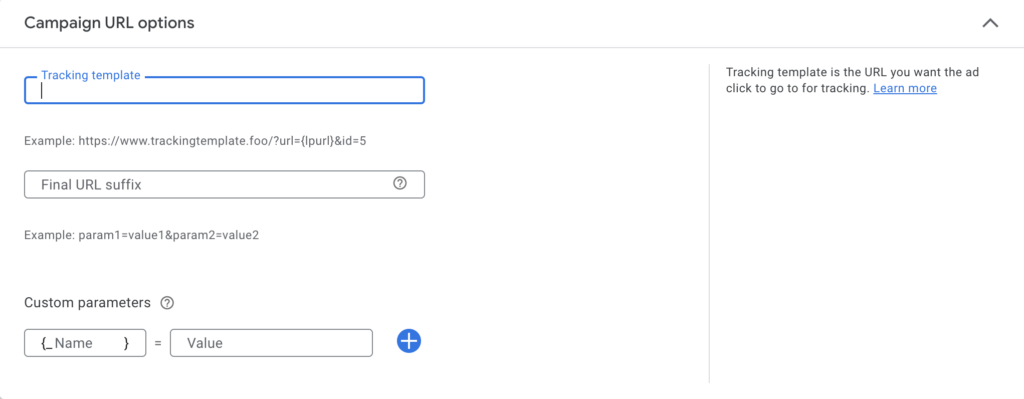This post is the second in a six-part series outlining the fundamentals of building your first PPC account through Google Ads.
Now that you have structured your Google Ads account (PART 1: Structuring Your Google Ads Account), it’s time to create your first set of campaigns! When creating a Google Ads campaign, you must understand your options within the campaign settings.
Campaign settings are applied to each ad group within that campaign. That said, things like daily budget, network selection, and locations, among other settings, are uniform for the entire campaign.
Let’s dive into the standard settings within every Google Ads campaign.
Networks

Search Network
The Search Network publishes your campaign on Google’s search engine results page (SERP) and other Google sites like Maps, Shopping, and Images. When selecting this network, you can also show your ads on Google’s search partner sites. These sites usually act as search engines, like Amazon, Wal-Mart, or Target.
Display Network
The Display Network hosts visual ads (primarily image and video) on various websites and Google-owned properties like Gmail and YouTube. These ads show up as banners.
Pro-tip: The use of Google’s search partners should be decided based on the data. You can opt-in when you set up your campaign and opt-out at any time.
Location Targeting

Google will deliver your ads in specific geographic locations or conversely exclude them from geographic areas depending on your location targeting settings.
When setting up a new campaign, Google will give you a few options for target locations. You can select from all countries and territories, the US and Canada, just the US, or custom locations.
First, determine where your target market is located.
You can divide targets into geographies by country, state, city, zip code, or a radius around a specific location. You can also decide whether you want to target people who are only present in the selected locations or people who are present or have shown interest in your target areas.
Pro-tip: Remember the capabilities and scope of what your business delivers. If you are a local business with a physical location, be conscious of how far your typical customers travel to get to your store. If you don’t ship internationally, keep your targeting within the United States. Read our post about successfully executing a local PPC strategy for more information about location targeting.
Languages

New campaigns always default to target English-language users. Your language targeting should typically match the language used in your keywords, ads, and landing pages.
If you want to deliver ads to people who speak Spanish in the United States, you would set the United States as your location and Spanish as your target language.
Audience Segments

Although this step is not required to build a campaign, we recommend utilizing the “audience segments” setting.
Select the demographics of your target audience (i.e., parental status, marital status, education, homeownership status, and employment), their affinities (i.e., interests and habits), what they are actively researching and planning, and how they have interacted with your business.
When getting started, we suggest selecting from the audience segments that Google recommends based on similar advertisers For example, if your business sells jewelry, Google may recommend observing people in the market for “Jewelry & Watches,” “Fine Jewelry,” or “Luxury Shoppers.”
Pro-tip: You will have the option to set your audience segment to “targeting” or “observation.” Setting audience segments to “targeting” narrows the reach of your campaign to only the selected segments. Setting audience segments to “observation” will still show your ads to people outside your target audience and allow you to gather data and set bid adjustments based on the results. We recommend starting with the “observation” option.
Broad Match Keywords

Google now allows you to set your keywords to “broad match” on the campaign level. Using this setting means your ads will show up for searches that are related to your keywords but don’t necessarily contain them.
Turning this setting “On” changes all existing keywords in your campaign to “broad match,” and all keywords added in the future will be “broad match.”
Selecting “Off” lets you use various match types in your keywords.
Pro-tip: It’s best to leave the “broad match” keyword setting off when getting started so you can see what kind of keyword match type works best for your campaign. Once you have data, you can decide whether to broaden or narrow your keywords’ scope.
Automatically Created Assets

Typically, you decide which headline and description assets to utilize while creating your ad. The “automatically created assets” setting allows Google to automatically create headlines and descriptions for your campaign’s ads based on the content of your landing page, ads, and keywords.
This setting may help with your ad’s relevance and performance, but you can leave it off if you want to maintain more control over your ad copy.
Pro-tip: We don’t recommend utilizing “automatically created assets” while you’re starting your campaign so you don’t lose full control over how your ads appear. If you need help coming up with new headlines in the future, you can always implement it then.
Ad Rotation

“Ad rotation” gives Google permission to optimize which combinations of headlines and descriptions your ads appear in.
Pro-tip: We recommend advertisers utilize this automation option as it prevents you from needing to manually test different headline and description combinations.
Start and End Dates

Set a start and end date for your campaign in the “start and end dates” setting. Typically, you’ll want to leave this setting off for ongoing campaigns, but it can be helpful for short-term campaigns, like seasonal promotions.
Ad Schedule

Select which days and times of day you’d like your ads to show in the “ad schedule” setting. Ad scheduling can be helpful when your business has specific hours of operation because you can stop showing ads when your business is not open to field calls or leads.
Campaign URL

Utilize the “campaign URL” setting to collect more complex performance insights, like tracking which campaigns generate the most profitable leads.
The URL template simplifies the performance tracking process by allowing you to measure KPIs without manually tagging every keyword or ad.
Getting Started in Campaign Settings
These days, Google gives you many settings to play with when setting up a new campaign. The most critical campaign settings to start with are:
- Networks
- Location
- Languages
- Audience Segments
Read our in-depth guide on Google Ads Account & Campaign Settings for additional insights on choosing the right campaign settings.
Continue optimizing your PPC strategy and check out the rest of our six-part “Building Successful PPC” series:
PRIMER: What is PPC – Pay Per Click Marketing Explained
PART 1: Structuring Your Google Ads Account
PART 2: Understanding Campaign Settings (you are here)
PART 3: Researching Keywords
PART 4: Creating Effective Responsive Search Ads (RSAs)
PART 5: The Best Google Ads Extensions to Implement
PART 6: Tracking Success









